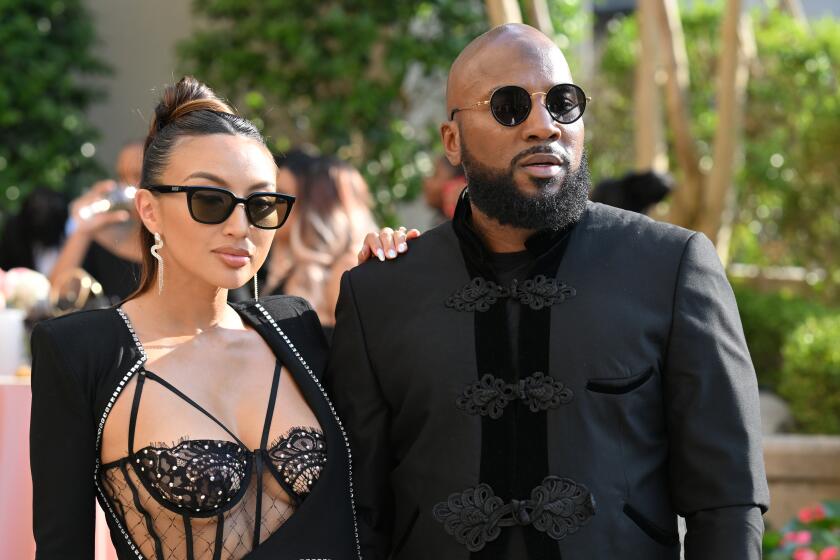Sweet Dreams, Revisited
First they were lovers. Then they created one of the great pop groups of the ‘80s. Then they didn’t exchange a word for four years.
For Eurythmics singer Annie Lennox and guitarist-arranger-producer Dave Stewart, the reunion began in 1997 with bereavement and a phone call.
“I was at my house above St. Ann’s Bay in Jamaica when somebody shouted, ‘Telephone!’ ” Stewart recalls. He is sagging with fatigue on a dressing-room sofa backstage at Wembley Stadium here just after Eurythmics’ set at the NetAid benefit concert earlier this month.
“Out of the blue, it’s Annie,” Stewart, 47, continues. “She was very emotional because Peet Coombes, from our previous group, the Tourists, had died. She’d got really upset. We talked for nearly two hours.”
Sorrow shared broke the barrier and led directly, if very slowly, to this fall’s comeback: a new album, “Peace,” due in U.S. stores Tuesday (see review, Page 78), recent appearances on Letterman and the “Saturday Night Live” anniversary special, upcoming spots with Leno and Rosie, and an international concert tour that includes a Staples Center concert Nov. 4.
What are the prospects for “Peace”?
“It’s a new and competitive playing field in terms of having big hit albums,” says Wayne Isaac, executive vice president of VH1, which will feature Eurythmics on a “Storytellers” show Dec. 12. “After that it’s about how hard they work and whether they have a big hit single. . . . There is a good potential for word of mouth taking it well beyond their old core fans so that a younger audience can discover them.”
Despite the 10 years passed since their last major gig together, Lennox and Stewart (Eurythmics were always the duo plus a roster of session aces) brought it all back with old songs and new in front of 75,000 at Wembley’s portion of the three-city NetAid event, which championed cancellation of Third World debt.
He paraded the familiar wild-streaked hair and contrasting inner calm, while her performance embodied her characteristic declaration of loathing for life’s “mid-gray zones.” For Lennox, there is exaltation and there is misery, and nothing much in between.
“I’m not a manic-depressive, but I’m almost there,” she admits in an earlier interview at a London TV studio, where Eurythmics are rehearsing for a performance on a talk show. Severe, schoolmarmish specs in place nowadays, she leans forward, poised like a sprinter in the blocks, talking fast, but with every syllable plainly from the heart.
“So many highs and lows. My way of coping is to write about it and sing it out: catharsis. Otherwise what? You get cancer?”
At 44, her face, 20 feet high on the stage-side screens at Wembley, tells her story: deep vertical frowning furrows between her eyebrows, deep crescent-shaped smile lines at either side of her mouth. First time around, Eurythmics were a band for whom MTV arrived as if by appointment. In 1983, they persuaded their then label, RCA, to release a radical video for their breakthrough single, “Sweet Dreams (Are Made of This).” It featured Lennox sporting cropped orange hair and a business suit. Plus the occasional passing farmyard animal.
The single sold a million, launching Eurythmics into hectic global orbit. Their music shook hearts, brains, bodies, and if there can be a rational explanation for the timely eruption of such talents after a previous track record of failure, then it must lie in their extraordinary relationship.
Lennox, from Aberdeen, Scotland, daughter of a shipyard worker, studied classical piano and flute at school and won a place at London’s prestigious Royal Academy of Music. But after hearing Stevie Wonder, she came to detest its academicism and quit before her exams.
Stewart, an accountant’s son from Sunderland in northeast England, had soaked himself in blues, folk and rock ‘n’ roll from boyhood. He went on to record a couple of mediocre albums with a group called Longdancer and consume an unnerving amount of LSD until he was introduced to Lennox in 1976 at the London restaurant where she was a waitress.
His first words were, “Will you marry me?” That was a joke, but they ended up in love. They lived together for four years, the duration of the Tourists, which recorded three albums. But then came the metamorphic crisis of their musical lives. Within a few weeks in 1981, the Tourists split up, Lennox and Stewart separated as a couple, and he had a near-fatal car crash. Yet when she visited him in the hospital, they decided they did have a future.
“We sacrificed our relationship to creativity rather than sacrifice our creativity to our relationship,” Stewart reckons.
The next nine years were great, but confusing, and ultimately too much. Lennox knits her brow over the memories. “It was very intensive. The momentum starts to overwhelm you. At a certain point, it kind of rubs you out.”
“When we stopped, it was nothing to do with our arguments over music,” Stewart affirms. “It was the bombardment of recording, touring, filming. We were never out of each other’s company. In the end, we couldn’t bear to be in the same room together.”
Lennox had one six-month marriage fiasco in 1984. But when Stewart married Siobhan Fahey, from the British vocal group Bananarama, and Lennox wed Israeli film director Uri Fruchtmann, Eurythmics’ ongoing creative romance imploded. “Dave and I had burned each other’s bridges,” the singer says.
And both proceeded to have a great time.
Always hyperactive, Stewart lived and worked off the graph: He filmed a blues documentary and co-wrote directed a feature movie called “Honest,” with plans for U.S. release next spring; he led a hobby band called the Spiritual Cowboys and recorded with, and/or produced, and/or played with, and/or wrote with Lou Reed, Bob Dylan, Leonard Cohen, Paul McCartney and many others; he took up photography and produced filmic art installations that have been exhibited at the Museum of Modern Art in Paris and in the Whitney Biennial in New York; he wrote the score for Robert Altman’s recent film “Cookie’s Fortune”; he had two children and got divorced.
Meanwhile, Lennox proved to herself that she was artistically all right without him by recording two multi-platinum albums, “Diva” in 1992 and “Medusa” three years later. But her more constant focus was on her husband and two children. More fundamentally, she suspects, she went through a phase when she didn’t “value” creativity enough because her memories of the music business circus were so painful.
*
But then she made that phone call to Stewart, and they resumed distant, amiable contact until early last year, when they were asked to play as an acoustic duo at a mutual friend’s going-away party. Something happened.
“I went ‘round Annie’s house to run through the old songs,” says Stewart. “We were in the kitchen, Annie singing away and making a cup of tea, when I started to play something new and she looked up and said, ‘Oh, that’s good’--and that was the moment it started again, because it was an instant Eurythmics song, you could tell immediately.”
Lennox says that inspirational fragment became “17 Again,” the first single from “Peace.” Spurred on by a charity appearance and an awards ceremony, they found themselves writing fluently, then recording--for Arista Records, which released their last album in 1989 and still had them under contract--until they had to own up. They had an album. Eurythmics were back.
“It was such a rediscovery of each other’s strengths,” Lennox enthuses with one of her high-beam smiles. They have made no decisions about their longer-term future as a duo, only bandied grand ideas such as Stewart’s “Let’s hire an orchestra and the Royal Albert Hall for a fortnight.”
“I really do love working with Dave,” Lennox continues. “It’s exciting! We go into the studio at the beginning of the day; we come out at the end of the day, and there’s a song. In my opinion, ‘Peace’ is the best album we’ve done. I’m shocked by its potency.”
This, she argues, is a “mature” power. Where the duo used to write some of their best songs on the adrenaline of conflict--”Here Comes the Rain Again” resulted from a wrestling match on the floor of a New York hotel room--their fortysomething selves are more civilized.
“I’m less volatile,” she avers. “Our relationship is less angst-ridden. I don’t need to burden Dave with my anxieties, and we don’t go down those roads which inevitably lead to bad-mouthing and upsetting each other.”
“There’s something spiritual about ‘Peace,’ which I think is about us coming together again,” says Stewart. “I suppose if you’re in an all-encompassing relationship like we were--sexual, too--and then it transcends that by becoming creative, there’s another level, a. . . .” He flounders, unable to nail the notion down.
But Lennox, ever the purist, needs a more practical justification for Eurythmics’ comeback and her own re-immersion in the pop “cult of personality” that she refers to frequently and fiercely scorns.
“The reunion wasn’t planned, and it didn’t happen because we need the money,” she insists--credibly, since last year her wealth was cautiously estimated by Q magazine at $40 million and Stewart’s at $20 million. “I want to live an authentic life, true to my own beliefs. The legitimacy of the album is in the bond of creativity between Dave and me.”
*
But still she’s not satisfied with her case. Explanations from the artist’s inner world are not enough, she says. She has had a political awakening to wider perspectives. All the duo’s profits from their upcoming concert dates (which are mostly in Europe) will be donated to Amnesty International and Greenpeace.
“That’s what gives me a purpose,” she says. “If I didn’t have that at the core of it all, I don’t know that I could step on stage with the same feeling that what I’m doing is dignified. It is important that I have something to say, that I’m not just absorbed in my own angst and allowing other self-absorbed people to indulge themselves, too.
“We can use this platform in an elegant way to focus gently on the fact that people ought to carry membership cards for organizations like Amnesty and Greenpeace just like they have passports or driver’s licenses. Now I feel that I’m an activist, I’m on the bus. I put my money where my mouth is.”
More to Read
The biggest entertainment stories
Get our big stories about Hollywood, film, television, music, arts, culture and more right in your inbox as soon as they publish.
You may occasionally receive promotional content from the Los Angeles Times.






